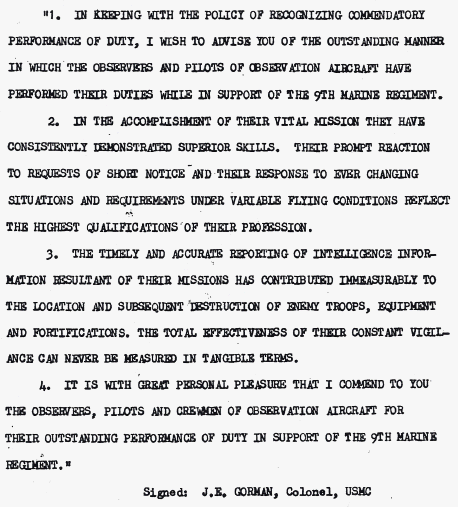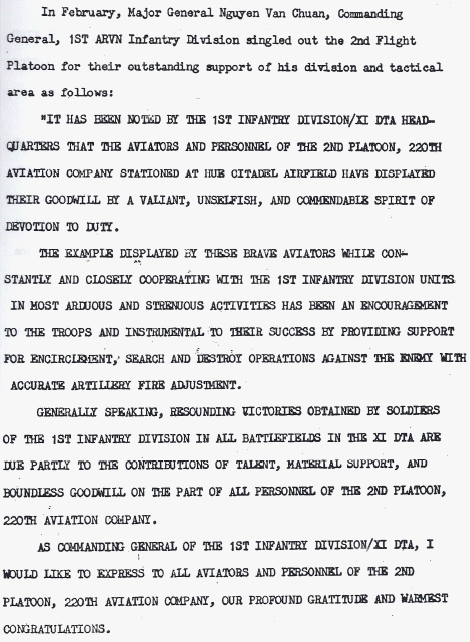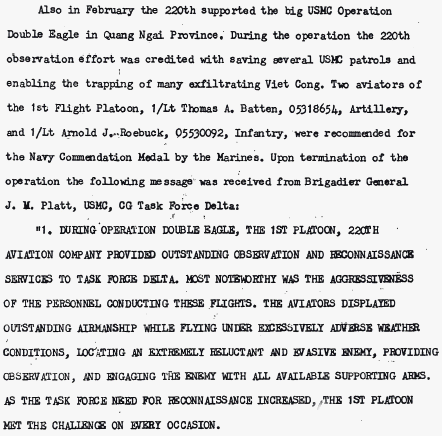Unit History of the
220th Aviation Company—1966 Overview:
Updated 25 December 2016
As the 220th weathered its first wet "Winter" Monsoon, the platoons flew their visual surveillance missions of all sectors of I Corps as frequently and diligently as possible.
After the first six months of having the 220th "Eyes in the Sky" in support of ground operations of the Marine and ARVN units throughout the I Corps TAOR, there was a solid feeling of appreciation and thanks for the visual observation, surveillance and reconnaissance plus the added capability for guiding of artillery and air strikes on enemy positions. The coming together of the G-2 Air sections of all the I Corps units at the end of December meeting hosted by Major Curry at the 220th in Phu Bai also began to prove its worthiness in the forthcoming coordinated efforts in the collection and distribution of intelligence. The support provided to both the USMC and the ARVN also resulted in the following official correspondence:
On 1 March 1966 Major Curry passed his command to Captain Schmale, the Executive Officer. Major Curry was reassigned as S-2 of the new 1st Aviation Brigade in Saigon. To insure some continuity in a series of changes within the personnel due to normal rotation which was about to come about, Captain Schmale and some twenty enlisted men extended their tours of duty with the unit for four months.
Then, as fate would almost dictate during the marginal weather, on 4 March the US Special Forces at the A Shau SF camp requested a reconnaissance of the A Shau Valley which revealed a tremendous buildup of Viet Cong forces immediately adjacent to the camp. Early on the morning of 8 March, the first of a series of attacks began that would finally result in the abandonment of the camp.
The first wounded Special Forces NCO was evacuated by WO1 "Mike" Misenheimer, 2nd Platoon of the 220th, under extremely hazardous conditions and a low ceiling. which also required him to climb on top and then let down to land at Phu Bai. MAJ "Bernie" Fisher (USAF) was awarded the Medal of Honor during this same action for landing in the midst of the raging battle and rescuing his A-1E wingman who had been forced to crash land his heavily damaged aircraft on the PSP strip. The 220th flew a total of 91 sorties during this battle of 8-12 March at A Shau with recommendations for two Air Medals w/V, eight Distinguished Flying Crosses and one Distinguished Service Cross and the unit was recommended for the Valorous Unit Citation for its participation in this battle. WO1 Misenheimer was awarded one of the DFCs, but we can locate no records of other awards. Captain "Dave" Rogers, Platoon Leader of the 2nd Platoon was recommended for the DSC for his valiant efforts in locating, protecting the crew of a downed USAF AC-47 and directing the rescue of the crew.
Upon the completion of the battle of A Shau and the abandonment of the camp, the following message and letter were received:
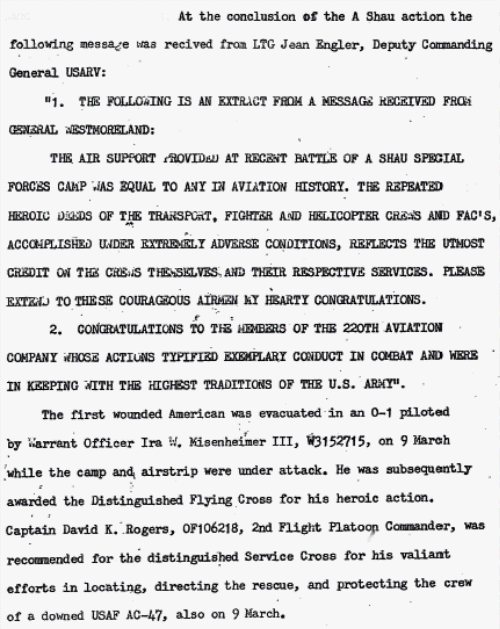
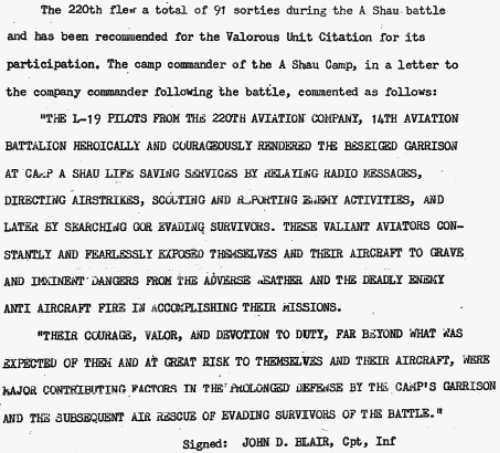
During the time that the battle of A Shau was going on and the entire unit was involved in support activities, the company was also undergoing an Annual General Inspection by the USARV Inspector General — coming through with flying colors.
Captain Schmale, the Company Commander, was promoted to Major on 18 March 1966 in a ceremony at Phu Bai.
During this time the 3rd Platoon moved its aircraft and all operations from Da Nang (Main) Air Force Base to the Marble Mountain Air Facility which at that time was a USMC facility.
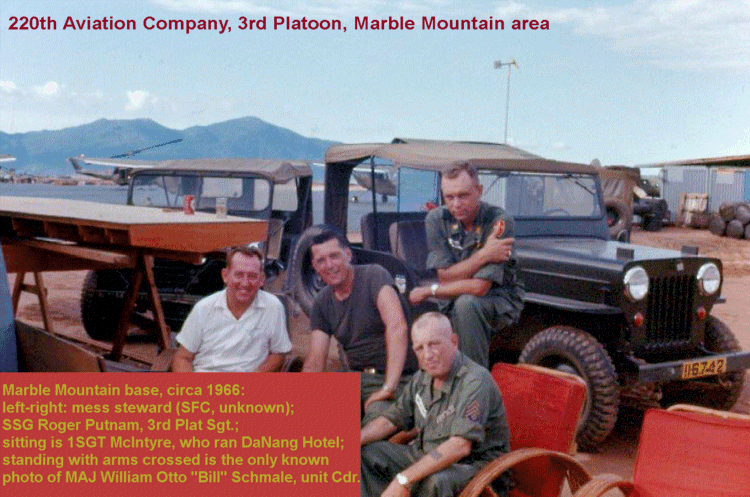
In May 1966, by direction of COMUSMACV, the 220th was provided training by the USAF and fully authorized (thus "blessed") to direct air strikes by US Air Force aircraft as Forward Air Controllers. Of course, our Platoons and Company Headquarters were already well indoctrinated and trained by USMC and Navy AOs and out in front of the power curve. Marine aircraft from the 1st Marine Aircraft Wing, Navy aircraft from carriers off-shore and various National Guard Unit aircraft did not really care who the FAC was as long as targets could be properly designated and their ordnance could be brought to bear. As an interesting sidelight, a short story should be told. After a few months at Quang Ngai with the 1st Platoon, Major Curry recommended that Captain Stuart Miller be assigned to the 12th Aviation Group in Saigon to write the Aerial Surveillance Plan for MACV in Vietnam. Stu spent the next 4 months flying a borrowed O-1 from the 74th Aviation Company to visit every Aviation unit and organization using aviation asset intelligence to develop the data necessary to write the plan. Then in March, Major Curry was moved to Saigon and once again became Stu’s boss. Since Major Curry had the most expertise by his unique assignment in I Corps with the Marines and was without any doubt the most experienced Surveillance Airplane Company Commander in all of Vietnam, the Curry-Miller team briefed the USARV Commander and received his blessing and concurrence to present the plan to MACV for approval. The results of the briefing to the MACV G2 left both Major Curry and Stu shaking their heads upon exit, as his decision was a one sentence declaration that "the plan is approved and that Air Force pilots (FACs) could fly Army airplanes and Army pilots could fly Air Force planes". Not knowing whether the General had dozed off during the briefing or what, the fact that Army O-1 pilots were fully capable and in the best position to conduct immediate control of air strikes on aerial intelligence developed appeared to have been accepted. The practice of flying airplanes regardless of service did not appear to have ever occurred resulting in a non-problem in FAC operations for either service.
On May 12th, a significant event occurred about 20 miles west of Da Nang, when a combat patrol from 1st Battalion, 9th Marine Regiment came under intense enemy contact and called upon a U. S. Army AO (aerial observer) to assist. A comprehensive accounting of this action is published in the April 2016 edition of Vietnam Magazine, article titled “Lost Patrol.” The unnamed army aerial observer referred to at pages 2–3 of the article was Warrant Officer Donnell L. Medley, of the 1st Platoon (Da Nang), 220th Aviation Company, who later received the Navy Commendation Medal, with the Combat Distinguishing (V) Device authorized:

Also in May the Senior Advisor, I Corps, submitted a recommendation for the Department of the Army Meritorious Unit Commendation for the 220th Aviation Company for the period July 1965-April 1966.
In June, WO Donnell L. Medley from 1st Platoon, Da Nang, would receieve another well–earned U. S. Navy award, the Distinguished Flying Cross, for a similar combat action (citation shown above) but which also resulted in the successful crash landing of his enemy–fire disabled aircraft (see citation link at DFC awards page):
On 6 June 1966, Unit Order Number 28, TC 322, UP of Marine Corps Bulletin 1650 dated 29 April 1966, named individuals, organization and station indicated, awarded the Navy Unit Commendation Ribbon bar for service by the HQ, 1st and 3rd Platoons, this organization, during period 18-23 August 1965.

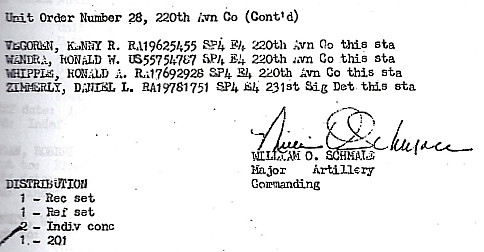
The month of July was the peak month of activity for the year in the participation of the 2nd Platoon and the Company Headquarters pilots in Operation Hastings, the largest USMC action in I Corps to date. The unit was once again recommended for a Navy Unit Commendation Ribbon bar (No record of award).
During August and September, participation in Operation Prairie resulted in yet another recommendation for a Navy Unit Commendation Ribbon bar for the 2nd Platoon and the Company Headquarters (No record of award). The admiration and respect of the 3rd Marine Division for the 220th quickly became a shared mutual relationship.
On 3 September, the 220th Aviation Company was reassigned from the 14th Aviation Battalion to the 223rd Aviation Battalion (a newly formed battalion of fixed-wing units), 17th Aviation Group, in Nha Trang. Our new Battalion Commander was LTC William K. Gearan. At this time, we also changed from the MACV to the new 1st Aviation Brigade shoulder patch.
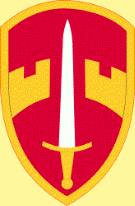
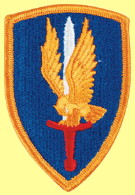
On 23 September 1966 we suffered the loss of CPT Robert "Bob" W. Garth, 1st Platoon Leader, near Mo Duc in southern Quang Ngai Province. With the aid of 1LT Kurt Lauer as a wingman, the USMC Aerial Observer (Name ?) flew the aircraft back to the Quang Ngai Airfield and survived a crash landing. (Recommendation for a Distinguished Flying Cross was disapproved by the USMC because he was just "doing his job".)
During late September—early October MAJ Schmale’s "last hurrah" was being able to get long awaited building materials released and transported from Da Nang to Phu Bai and work was begun by PA&E to replace the GP Medium Tents by more permanent wood structures for improvement of the company area.

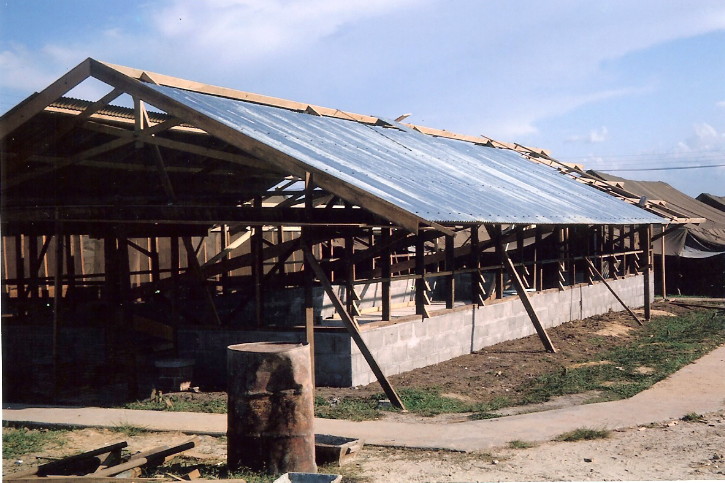
In October the 220th Aviation Company (SAL) was redesignated and became the 220th Aviation Company (Reconnaissance Airplane Company) or (RAC). At that time we were commonly referred to as the 220th Aviation Company (RAC). [It appears that this parenthetical designation was a designation by the 1st Aviation Brigade (or USARV or USARPAC) as it is not included on the Historical Data Card (Form 393) on file with the Department of the Army Center of Military History.]
On 14 October 1966 MAJ Schmale passed command to MAJ Robert V. Dunne (former S4, HQ 223rd Aviation Battalion).
With the return of the wet "Winter" Monsoon weather getting an early start, those from the 1st Platoon at Quang Ngai who were able to join us for Thanksgiving dinner at Phu Bai were almost actually "feet wet" all the way as they made their way up the coast under the low overcast.
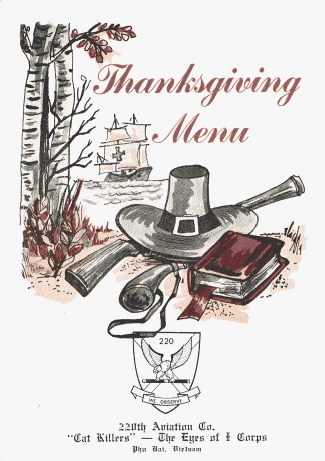
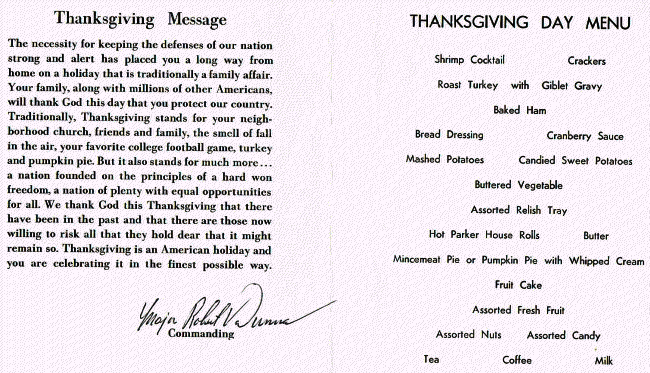
NOTE: Dennis Currie sent this special note regarding the menu he kept from his
first Thanksgiving Dinner in Phu Bai, 1966, which also was the same day he pulled KP for the Company event. Dennis goes on to say, "We worked
our tails off to make it a great day and even got the next day off for our work. I also saved the Stars & Stripes
article which tells about Lt. Pat O'Malley crash event. While the article didn't mention 1LT Rugge, it gave a great accounting of Pats thoughts during
the rescue.
I sent the menu as a greeting card back home and discovered years later that my mother had saved it. It's amazing what I thought writing home was about as a nineteen year old. Grin! Dennis Currie" [The article Dennis mentioned is now attached to Pat O´Malley's roster line in full detail.]
On Christmas Day, the following message was received at the 220th Aviation Company Headquarters from MG Walt, CG III MAF:

During this year there were 22,478 sorties flown for a total of 28,728 hours (the busiest year of all years from 1965 through 1971) with three platoons and considerable support from the headquarters company pilots.
COMPILER: Gene Wilson
